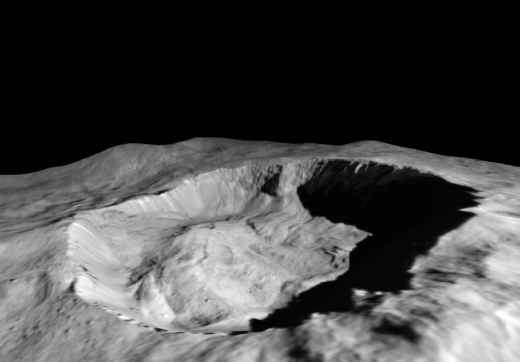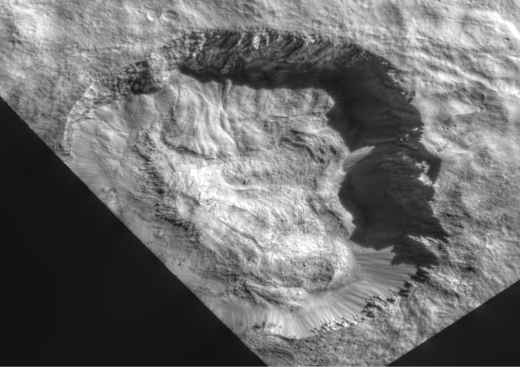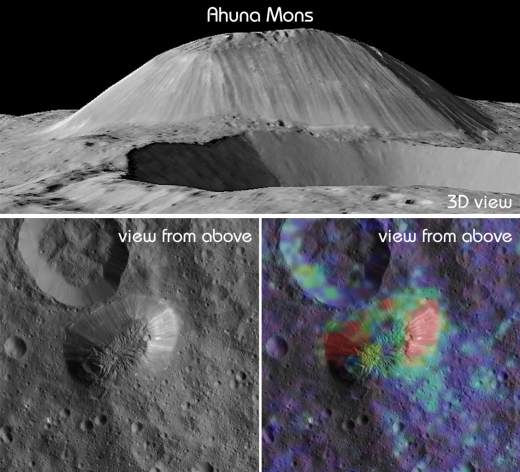Ceres turns out to be a livelier place than we might have imagined. Continuing analysis of data from the Dawn spacecraft is showing us an object where surface changes evidently caused by temperature variations induced by the dwarf planet’s orbit are readily visible even in short time frames. Two new papers on the Dawn data are now out in Science Advances, suggesting variations in the amount of surface ice as well as newly exposed crustal material.
Andrea Raponi (Institute of Astrophysics and Planetary Science, Rome) led a team that discovered changes at Juling Crater, demonstrating an increase in ice on the northern wall of the 20-kilometer wide crater between April and October of 2016. Calling this ‘the first detection of change on the surface of Ceres,’ Raponi went on to say:
“The combination of Ceres moving closer to the sun in its orbit, along with seasonal change, triggers the release of water vapor from the subsurface, which then condenses on the cold crater wall. This causes an increase in the amount of exposed ice. The warming might also cause landslides on the crater walls that expose fresh ice patches.”

Image: This view from NASA’s Dawn mission shows where ice has been detected in the northern wall of Ceres’ Juling Crater, which is in almost permanent shadow. Dawn acquired the picture with its framing camera on Aug. 30, 2016, and it was processed with the help of NASA Ames Stereo Pipeline (ASP), to estimate the slope of the cliff. Credit: NASA/JPL-Caltech/UCLA/MPS/DLR/IDA/ASI/INAF.
Ceres was moving closer to perihelion in the period following these observations, so we would expect the temperature of areas in shadow to be increasing. Sublimating water ice that had previously accumulated on the cold walls of the crater would be a natural result, and while acknowledging other options — such as falls exposing water ice — the researchers favor a cyclical trend similar to cycles of water ice seen, for example, at Comet 67P/Churyumov-Gerasimenko. From the paper:
The linear relationship between ice abundance and solar flux… supports the possibility of solar flux as the main factor responsible for the observed increase. The water ice abundance on the wall is probably not constantly increasing over a longer time range. More likely, we are observing only part of a seasonal cycle of water sublimation and condensation, in which the observed increase should be followed by a decrease.

Image: This view from NASA’s Dawn mission shows the floor of Ceres’ Juling Crater. The crater floor shows evidence of the flow of ice and rock, similar to rock glaciers in Earth’s polar regions. Dawn acquired the picture with its framing camera on Aug. 30, 2016. Credit: NASA/JPL-Caltech/UCLA/MPS/DLR/IDA/ASI/INAF.
A short-term variation in surface water ice shows us an active body, a result that meshes with further observations from Dawn’s visible and infrared mapping spectrometer (VIR) showing variability in Ceres’ crust and the likelihood of newly exposed material. The work, led by Giacomo Carrozzo of the Institute of Astrophysics and Planetary Science, identifies twelve sites rich in sodium carbonates and takes a tight look at several areas where water is present as part of the carbonate structure.
Although carbonates had previously been found on Ceres, this is the first identification of hydrated carbonate there. The fact that water ice is not stable over long time periods on the surface of Ceres unless hidden in shadow, and that hydrated carbonate would dehydrate over timescales of a few million years, means that these sites have been exposed, says Carrozzo, to recent activity on the surface.

Image: This view from NASA’s Dawn mission shows Ceres’ tallest mountain, Ahuna Mons, 4 kilometers high and 17 kilometers wide. This is one of the few sites on Ceres at which a significant amount of sodium carbonate has been found, shown in green and red colors in the lower right image. The top and lower left images were collected by Dawn’s framing camera. The top image is a 3D view reconstructed with the help of topography data. Credit: NASA/JPL-Caltech/UCLA/MPS/DLR/IDA/ASI/INA.
Taken together, the water ice findings and the presence of hydrated sodium carbonates speak to the geological and chemical activity that continues on Ceres. As the paper notes:
The different chemical forms of the sodium carbonate, their fresh appearance, morphological settings, and the uneven distribution on Ceres indicate that the formation, exposure, dehydration, and destruction processes of carbonates are recurrent and continuous in recent geological time, implying a still-evolving body and modern processes involving fluid water.
The papers are Carrozzo et al., “Nature, formation, and distribution of carbonates on Ceres,” Science Advances Vol. 4, No. 3 (14 March 2018) e1701645 (abstract); and Raponi et al., “Variations in the amount of water ice on Ceres’ surface suggest a seasonal water cycle,” Science Advances Vol. 4, No. 2 (14 March 2018) eaao3757 (abstract).



This caught my eye in the paper:
Does this imply that Ceres migrated inwards from a more distant orbit? If so, it might also be a more reachable body to investigate the subsurface composition of the icy moons, Europa and Enceladus.
A final note. Ceres is not just a potential H2O source for interplanetary travel and bases, but also a good reserve of NaCO3 which can be used in a number of processes, including glass making.
I think Ceres has not come in from the outer solar system because the eccentricity is low. I thinking ammonia is there from its formation because during the early times of the solar system it was close to the frost line. A constant rain of dust from the asteroid belt may have insulated the body from external heating by the sun. Or life may have got a hold on this world as it too can produce ammonia as a by product.
Is there any way to test either hypothesis, or is its origin always going to be ambiguous?
I am not sure a rover would do well here as the dust covering may be a problem with wheels and tracks. I suppose a ball would do well here with perhaps a hopping contraption on board, a bit like a Mexican jumping bean. As for life excreting ammonia I think a probe drilled into surface to analyse the chemicals with which it is mixed could tell i.e. chemical imbalances. Some life selectively use NH3 or NH4+ as well, however this is not my line of expertise. Perhaps we could have two spacecraft, one a bouncing ball and a Phoenix type craft. Due to the rapid rotation rate energy should not be a big problem even though it is further from the Sun.
https://www.nasa.gov/multimedia/imagegallery/image_feature_857.html
It would require intence study to determine the origin of Ceres, objects in the far end of Solar system have the composition because they are pristine.
And Ceres appear to be very similar, that’s why the idea it have migrated.
My view is the same as Michael, the orbit is very similar to other object in the asteroid belt, and so belong to the belt. The problem is that Ceres is alone without a second asteroid/dwarf planet of similar size. That would have made a determination of origin easier from the beginning.
The two ideas might be around for a long time.
Isn’t it time we started planning a Ceres rover? Probably easier in some ways than a Mars rover, given the lack of wind blown dust.
With just 3% Earth’s g, it would be less of a “rover” and more of a “climber”. The vehicle almost needs to hold itself to the surface if it is to move about and react with the surface to take samples. I’d like to see some speculative designs for such a vehicle.
You’ve probably seen those old videos of “hanging” astronauts to simulate lunar g of 1/6th Earth. Now think of the simulation for ~ 1/33rd Earth g to get an idea of the traction difficulties on Ceres.
The Philae lander was going to just anchor itself on the comet. It failed and bounced around until it rested in a fairly sunless location. Imagine how such a lander also designed to move about. It might have to set up piton anchors and cables and scale the surface rather like climbing a near vertical rock face.
Perhaps an optional “lander” that can perform a useful mission even if it cannot touch down long enough. The NEAR spacecraft is my hero. If it must touch down – say to grab a sample for onboard assay, do so with a small swiper. Overall I am hoping with launch costs coming down we can bring spacecraft costs down too. NASA/ESA/JAXA should begin focusing on the opportunities evolving from cubesats with interplanetary capability for initial probe missions. At smaller size they can be accelerated to greater velocity to reduce travel time and multiple craft could be carried on a single launch vehicle. There are many serious efforts underway by several developers that are advancing areas such as propulsion, GNC, and radiation tolerance for for these. Some reading can be found in papers such as this one https://icubesat.org/papers/2017-2/2017-b-1-5-wayfarer-on-demand-small-body-exploration-with-a-common-architecture-spacecraft/
A lander will ideally be able to analyze both surface and subsurface samples, and well as do a number of experiments to justify the cost. I am certainly with you on the idea that smaller craft might be able to do the same task using a different approach. For example, rather than moving over the surface, a swarm of nanocraft could “land” at various points on Ceres instead. Some may be penetrators to reach the subsurface. Obviously harder to do today, but maybe more feasible in the near future.
At 3% gravity, you just need to move with 3% of the acceleration you would on Earth. Very hard for a human to do, we’re absurdly over-powered for 3% gravity, our reflexes are all wrong, and we’re not patient enough to accept moving like molasses to avoid bouncing off the surface. Dirt simple to design a machine to do. The power to mass ratio goes down, loading on joints goes down, less wear, control algorithms have more time to respond.
It gets a bit dicey once you want to do something that requires applying forces that scale with material, rather than gravity. Drilling holes, for instance. But just getting around? Should be easy.
Might be a good opportunity to try out a walking rover; Walking isn’t as efficient as rolling, but at 3% gravity, you don’t need efficiency. And the joints can all be encapsulated in bellows to be dust proof.
Testing on Earth would be fun, though. You’d have to come up with a system of counter-weights to support 97% of the rover’s weight, just so that it wouldn’t collapse.
Dawn Mission: Shedding Light on Asteroids
By Nola Taylor Redd, Space.com Contributor
May 1, 2018 12:24 am ET
Credit: NASA/JPL-Caltech
When NASA’s Dawn mission launched in 2007, it was on its way to breaking several records. When it entered orbit around the Vesta, it became the first to orbit a main-belt asteroid. After leaving Vesta, it journeyed on to Ceres, becoming the first spacecraft to visit and then orbit a dwarf planet and the first spacecraft to orbit two extraterrestrial targets.
The journey hasn’t been smooth. Along the way, the spacecraft lost threeof its four reaction wheels that keep it oriented. It successfully concluded its primary mission to study both targets in 2016. Once it runs out of fuel near the end of 2018, it will continue to orbit Ceres for another 50 years.
“To me, the real story here is how cool it is that we’re exploring what, in my view, are some of the last uncharted worlds in the inner solar system,” chief engineer and Dawn mission director Marc Rayman told Space.com. “Most people think of asteroids as chips of rock, but these are whole new worlds.”
https://www.space.com/40454-dawn-mission.html